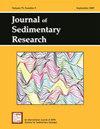Mineralogical composition, isotopic and geochemical characteristics of Pleistocene glendonites from the outcrops of Bol’shaya Balakhnya River, Eastern Taimyr, Russia
IF 2
4区 地球科学
Q1 GEOLOGY
引用次数: 0
Abstract
We present a complex study on mineralogical, U/Th dating, isotopic and geochemical characteristics of Pleistocene glendonites (calcite pseupomorphs after ikaite) from the outcrops of Bol’shaya Bakakhnya valley, Eastern Taimyr, Russia. Based on the U/Th dating of the glendonites (37 ± 7 ka) we propose that the glendonites and host sediments were formed during Karginsky interstadial (22—50 ka) – this data corresponds well with published ages of foraminifers and wood fragments from Karginsky deposits of Eastern Taimyr. The main factors leading to ikaite crystallization was presence of organic matter (δ13C varies from -5 to -40‰ V-PDB) in the host clayey sediments and low temperatures (< 7 ºC) of bottom water. Isotopic (δ18O ratios vary from -8 to -33.9‰ V-PDB) and geochemical (PAAS-normalized patterns of rare earth elements) characteristics of the studied glendonites confirm that ikaite crystallization and transformation was influenced by seawater. Carbon was derived from dissolved inorganic carbon, de composed organic matter, and probably methane. Some glendonites are surrounded by concretions (host rock cemented by calcite). The isotopic characteristics of the host concretions and glendonites are similar, so we assume that glendonites and host nodules were formed by the same processes—sulfate reduction coupled with anaerobic decomposition of organic matter. Nevertheless, geochemical characteristics of the host concretions and glendonites differ: Mg/Ca ratio and values of Fe, Mn, Zn, Cd, and U are higher in host concretion than in glendonite. This may reflect differences in crystalline structure of ikaite and high magnesium calcite.俄罗斯东泰米尔博尔沙亚-巴拉赫尼亚河出露的更新世砾岩的矿物组成、同位素和地球化学特征
我们对俄罗斯东泰米尔 Bol'shaya Bakakhnya 谷露头的更新世鹅耳石(方解石后的方解石前生体)的矿物学、U/Th 测定、同位素和地球化学特征进行了综合研究。根据陨石的 U/Th 测定年代(37 ± 7 ka),我们推测陨石和寄主沉积物形成于卡尔金斯基间期(22-50 ka)--这一数据与东泰米尔卡尔金斯基沉积物中有孔虫和木材碎片的公开年代十分吻合。导致伊卡岩结晶的主要因素是寄主粘土沉积物中有机物的存在(δ13C 在 -5 至 -40‰ V-PDB 之间变化)和底层水的低温(< 7 ºC)。所研究的榴辉岩的同位素(δ18O比率从-8到-33.9‰ V-PDB)和地球化学(稀土元素的PAAS归一化模式)特征证实,榴辉岩的结晶和转化受到海水的影响。碳来源于溶解的无机碳、有机物和甲烷。一些榴辉岩被凝块(由方解石胶结的主岩)包围。宿主凝块和砾岩的同位素特征相似,因此我们推测砾岩和宿主结核是由相同的过程形成的--硫酸盐还原加上有机物的厌氧分解。不过,宿主结核和胶东岩的地球化学特征有所不同:主凝块中的镁/钙比值以及铁、锰、锌、镉和铀的含量均高于胶东岩。这可能反映了依卡岩和高镁方解石晶体结构的差异。
本文章由计算机程序翻译,如有差异,请以英文原文为准。
求助全文
约1分钟内获得全文
求助全文
来源期刊
CiteScore
3.80
自引率
5.00%
发文量
50
审稿时长
3 months
期刊介绍:
The journal is broad and international in scope and welcomes contributions that further the fundamental understanding of sedimentary processes, the origin of sedimentary deposits, the workings of sedimentary systems, and the records of earth history contained within sedimentary rocks.

 求助内容:
求助内容: 应助结果提醒方式:
应助结果提醒方式:


